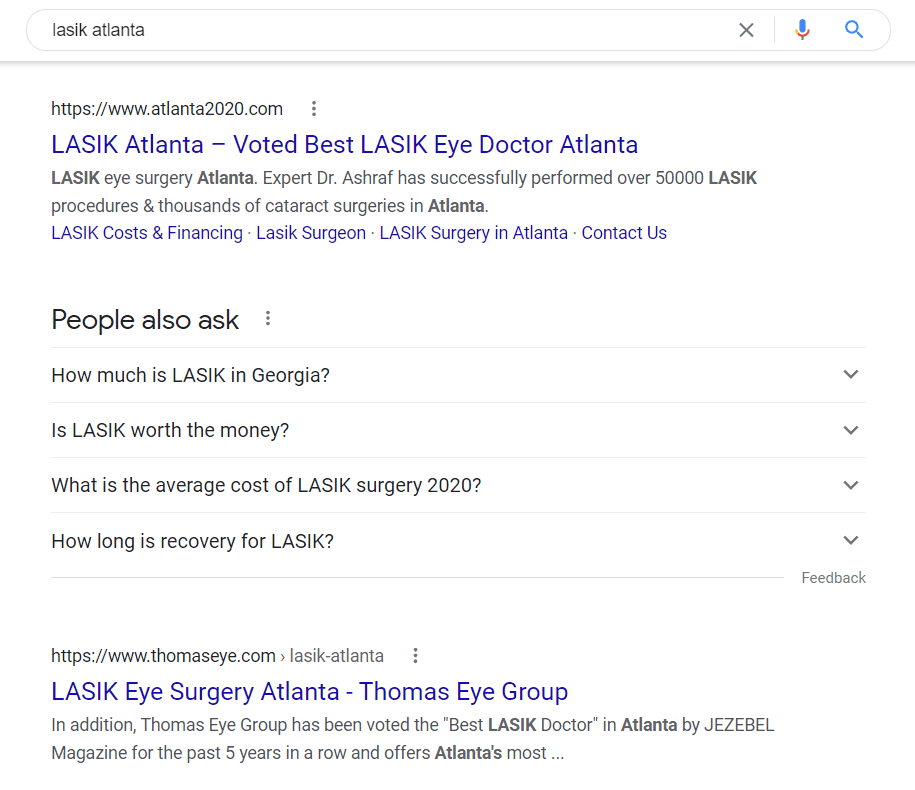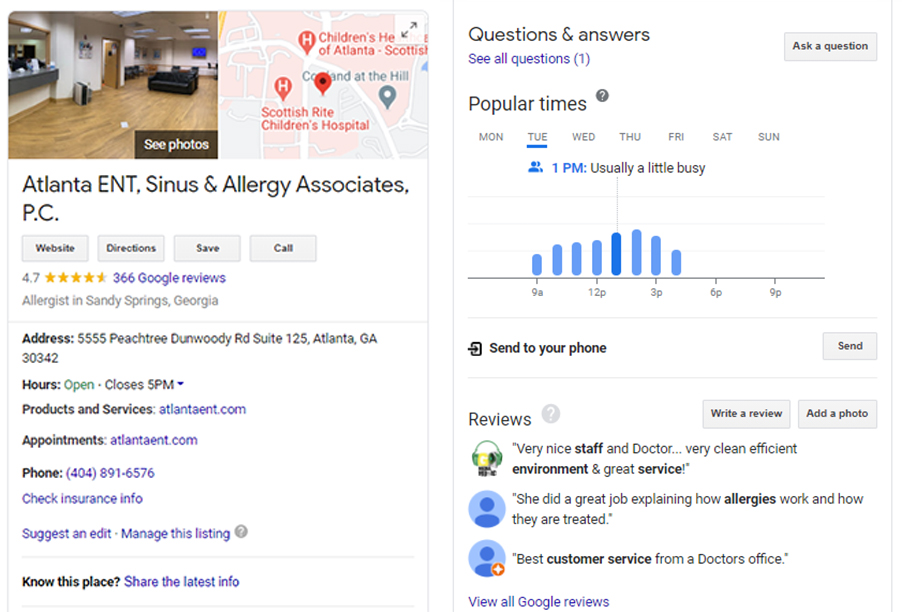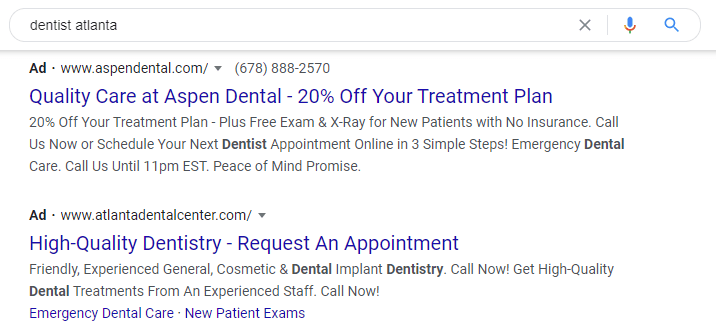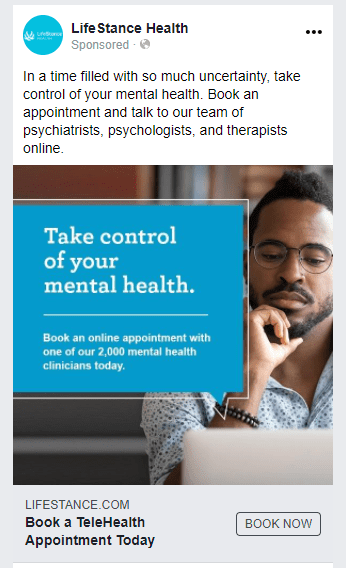The post-pandemic world has brought forth many new changes to the healthcare industry as a whole. Healthcare marketing efforts are evolving rapidly in order to keep up with the current competitive landscape and economic shift. Because patient-centric marketing has become the name of the game, your healthcare organization has got to heavily invest in acquisition-focused marketing strategies to get ahead of the competition. We’ll dive into five patient acquisition strategies to help you fuel growth in 2023.
Table of Contents
- What is Patient Acquisition Marketing?
- 1. Master Local SEO
- 2. Boost Search Visibility with Google Ads
- 3. Use Paid Social for Patient Acquisition
- 4. Build a Website Patients Love
- 5. Take Control of Your Digital Reputation
- Optimize BOF Campaigns to Cut Costs
- Measure the Success of Your Patient Acquisition Efforts
- Putting These Patient Acquisition Strategies Into Play
What is Patient Acquisition Marketing?
A patient acquisition marketing campaign aims to persuade potential patients to choose your clinic or hospital for their healthcare needs. To create a successful acquisition campaign, it’s crucial to emphasize the most exceptional features of your medical practice and use them to create an enticing vision of what a new patient will encounter during their visit.
It’s worth noting that patient acquisition strategies are focused on gaining new patients, in contrast to patient retention tactics, which aim to keep them coming back for care.
1. Master Local SEO
For ages now, we’ve been telling our healthcare clients that local SEO is an essential component of patient acquisition in the healthcare industry.
“A huge piece for a lot of local businesses is your Google Business Profile. Making sure that you have optimized listings that align with the content that you’re showing on your webpage is huge. That will help Google understand exactly who you are, where you’re located, and what you offer. That’s true for all listings, not just Google. It’s really important to make sure you’re managing that.” —Jacquelyn Green, Director of SEO
Here’s why: people tend to search for and visit healthcare providers that are nearby. Your Austin plastic surgery folks are probably looking to get their nose job done in Austin. And your Atlanta people shopping for a LASIK provider probably want to find a laser located in town. In response to this local demand, Google and other search engines are getting very good at stitching together highly relevant local search experiences.

Therefore, if this is your first time developing a formal patient acquisition marketing strategy, start with SEO. While SEO tends to be a long-term investment, once done, it is always yours. In the end, effective SEO will turn into a well-oiled machine and continue to drive new patients long into the future.
How to Optimize for Local SEO
When people search locally, they tend to follow through and show up in person. According to Google, 76% of smartphone users who search for things nearby visit a business within 24 hours. That goes for your prospective patients, too. By optimizing your content, business listings, and overall digital presence for one or more local markets, you can make sure you reach them.
At a high level, your objective is to send lots of signals to Google that you’re an active, authoritative, and reputable provider in a given geographic area. While there are a variety of ways to do so, here are a few fundamental parts of a local SEO strategy:
- Local citations/Listings: There are more places to list your healthcare practice than just Google Business Profile, Bing Maps, Yelp, and Facebook. You got ZocDoc, Vitals, and other sites managed by different healthcare groups like Sharp and Northwestern Medical. But you’ve got to manage all of them and keep them accurate and up-to-date. And don’t forget, each location needs its own listing and make sure your business name, address, and phone (NAP) are the same across all listings.
- Google Business Profile: Having a stellar Google Business Profile is arguably the most important factor when it comes to local SEO. First, set up your GBP listing with a verified address, relevant categories, and thorough details. Then, regularly update your profile by posting photos, videos, and info on new promotions, answering user questions, and sharing operational updates. Don’t forget to stay on top of your Google Reviews too!
- Location-specific pages and content: Healthcare organizations need to have different web pages for each location, no excuses! The idea is to make it super easy for patients to find what they need for their specific location with minimal clicks. Create pages for each location that include useful information for both your patients and the search engines. Include relevant keywords, make UX a priority, have distinct URLs, and create a scalable template that can be used for each location.
- Locally relevant backlinks: When authoritative websites link back to your location-specific web pages, it tells Google’s algorithm that your website is both reliable and helpful. Local directories provide a simple and free method to publish NAP (name, address, phone number) information for various locations while also gaining valuable backlinks. Partnering with local industry-related websites, publications, and media to create content is also a great way to build your backlink portfolio.

The idea is to cover these bases for each of your locations. By consistently churning out this kind of rich local content, healthcare organizations supply search engines with all kinds of information to surface in all kinds of local search experiences, including:
Even healthcare marketing experts like Paul Gruensfelder, Vice President of Marketing, Select Dental Management are shifting their focus to local SEO in 2023. “Obviously, where you rank on the page is really important, but [Google] maps is super important. We’re in a local business, we provide a local service, and I would tell you, that’s where I want to be primarily.”
RELATED: Does your practice have multiple locations? Take a look at How to Boost Local Rankings for Multi-location Medical Groups
2. Boost Search Visibility with Google Ads
However, most healthcare businesses cannot wait six to twelve months for a longer-term SEO strategy to start creating bottom-line value. That is why paid search goes hand-in-hand with a mature SEO program to attract new patients.
When configured properly, PPC advertising can begin generating new patient leads as soon as they’re launched. Dominating the top half of the SERP, paid search helps healthcare providers gain search share in competitive markets and supports areas where your organic SEO is yet to be built.
For instance, say you want to increase the ranking for a competitive local keyword, but aren’t seeing immediate results. With PPC, you can slap an advertisement at the top of that SERP above the organic results while continuing to build your organic rankings.

How to Increase Patient Acquisition with PPC Campaigns
By placing your information at the right time, on the very top of the page, and in front of the right people, you can land a new patient, appointment, booking, and so on as soon as your campaign goes live. However, how do you know if you’re doing it right?
The fact is, even advanced marketers often use outdated best practices because of how rapidly Google is developing its technology. Within the past few years, Google’s machine learning and AI enhancement, alongside their continued emphasis on consumer experience have drastically changed how PPC works. By combining automation with creative messaging and end-to-end strategies, you can continually perfect your patient acquisition strategy in 2023.
“I think agencies and marketers should be excited about the fact that Google has taken that on because now they can focus on other things. The more strategic things. Like, am I saying the right things to my users in my messaging? Do I understand the buying decision?
Am I reinforcing motivations? Am I removing hurdles? Am I tackling the anxiety and friction? Do I have a great landing page? Am I testing landing pages and ad copy? These are all things that are not going anywhere that allow agencies and in-house marketing teams to flex their marketing chops and be a lot more strategic.” —Rich Briddock, SVP Strategy & Analytics, Cardinal
Meanwhile, below are a few things to keep in mind:
- With machine learning developments, the old, rigid way of optimizing for keywords is becoming less efficient. Today’s ad campaigns must connect and engage with audiences by serving up the perfect solution at the right moment, and it goes so much more than throwing web page links into one big ad and straight entering a bidding war.
- The future is broad match. Google is encouraging the use of automation and AI in its advertising solutions, leading to the decline of traditional “exact match” and exposing the limitations of other keyword matching options. Advertisers must adapt to these changes by using “broad match” type in their campaigns to stay up to date.
- Responsive Search Ads (RSAs) are now the default. By showing patients the most relevant ad copy, RSAs can significantly improve campaign performance and ROIs. While many healthcare providers previously relied on expanded text ads, starting June 30, 2022, responsive search ads will be the only Search ad type allowed in standard search campaigns. So, now is the time to get familiar with RSAs!
- Performance Max Campaigns are a new way to buy across channels, including YouTube, Display, Search, Discover, and more. Since it’s considered the next-gen solution for local campaigns, it is vital that healthcare providers take full advantage of Performance Max Campaigns to attract local patients.
Therefore, if you’re currently leveraging Google Ads for patient acquisition, it’s worth conducting an audit before implementing any new strategy. With most healthcare marketers using sophisticated automated bidding strategies to keep CPA down and control ad spending, a comprehensive audit will show you how to optimize what you have and make up for what you’re missing when it comes to patient acquisition with PPC campaigns.
RELATED: For more on PPC strategies and best practices for healthcare providers, see 5 Core Pillars of PPC Strategies that Win New Patients.
3. Use Paid Social for Patient Acquisition
Social media works. However, when it comes to online patient acquisition, you must pick and choose and spend your budget wisely.
Don’t get us wrong. We love social. But we don’t recommend investing in social media unless you’ve established a solid SEO and PPC foundation. Once you’ve maximized your organic and paid search effort, then it’s time to move onto social media, specifically Facebook and Instagram.
The best thing about these social channels is how they provide various ways to listen to and engage with your audience. That’s why many healthcare businesses leverage social media as their primary branding platform.
There, they steadily publish a variety of content, including educational videos, Facebook Live, Instagram Reels, video testimonials, and other information to provide value to their audience and create rich engagement. This kind of living, breathing, and growing Facebook presence is a powerful way to increase brand awareness and strengthen brand affinity.
Nonetheless, while your potential patients are indeed on Facebook and Instagram, simply bringing yourself in front of the audience is not enough to generate immediate leads. You must marry performance marketing with branding if you want your social media strategy to drive patient acquisition.
How a Full-Funnel Facebook Ads Strategy Yields More Qualified Leads
Like we’ve mentioned earlier, paid social has its merit. Compared to long-term SEO, a proper Facebook advertising strategy can deliver results much more quickly, although not as fast as PPC. However, for Facebook ads to work, a full-funnel strategy is a must.
So, what is a full-funnel advertising strategy?
As the name indicates, a full-funnel strategy tailors your campaign messaging according to each stage in your customer journey. It is a comprehensive strategy that covers TOF, MOF, and BOF, from an audience who just started showing interest to those about to convert.

Because a full-funnel strategy walks your target audience through the journey, it can often reduce the overall cost to generate a lead at the bottom of the funnel.
To build a successful full-funnel strategy, pay attention to the following:
- Brand Awareness: Leverage campaigns targeting the TOF audience to increase your overall brand awareness. Integrate your paid ads strategy with your organic social media content to attract potential prospects and initiate their patient journey. When costs are cheap, it’s a good time to invest in TOF efforts, granted you have maximized your Google Ads performance.
- Message Tailoring: It’s common sense. You can’t use the same message on an awareness stage audience and a conversion stage audience. Tailoring your messaging, which includes your ad copy, creatives, and CTA based on your audience’s customer journey stage will significantly increase your CTR and engagement.
- Retargeting: A full-funnel strategy walks alongside your future patient, meaning they keep your brand visible in front of them at all decision-making moments. By retargeting website visitors, app users, or people who have engaged with you on social media, you can reinforce engagement the with MOF audience. Because privacy restrictions and data regulations have changed the digital marketing landscape, you’re going to have a lot less information to base your retargeting campaigns on. Nonetheless, you can still gain deep insights by talking to patients, using A/B testing, focusing on contextual advertising, and using call tracking data.
- Diversify Ad Types: Today’s ad format goes beyond simple photos and videos. As the platform continues to develop, businesses can now incorporate carousels, lead generation forms, unique mobile experiences, even augmented reality!
- Make Conversion Easy: Make sure conversion is easy throughout your campaign, whether it’s a click to a landing page, a button to follow, or a direct Facebook Experience. Remember, the end goal of your Facebook ads is to increase patient volume.
4. Build a Website Patients Love
In the end, your goal is to increase your patient volume. Whether a patient called the number on your PPC ad or made an online appointment, you can guarantee that at some point they’ve landed on your website, which is why the strategies we’ve talked about above cannot reach their full potential without a responsive, friendly, and optimized website.
In other words, your website is the centerpiece of your patient acquisition strategy. On one hand, your website is your main communication channel with search engines, allowing you to be seen by the many users seeking a health solution. On the other hand, your website is the digital front desk that will either welcome your future patients with a warm smile or turn them away immediately. Therefore, you want to make sure your website creates a simple, seamless experience for your prospective and existing patients both.
Ask yourself these questions:
- Does your site navigation make sense? Can patients easily find what they need?
- Are all important, valuable information presented right at the beginning?
- Can your site load fast and properly on all devices?
- Is the content on your site timely and authoritative?
If you answered no for any of these questions, it’s time to create a better web experience for your patients. After all, it is people—not marketing dollars or campaign metrics—that make up for your patient volume. Therefore, let your patients guide your acquisition marketing strategies, whether that means finding an easier online scheduling tool or optimizing for local listings.
How to Build a Solid, Scalable Website Foundation
It is crucial to prioritize your digital presence in today’s technology-driven world. If your website is outdated, slow, or visually unappealing, this will discourage patients from taking the next steps with your practice.
Your website needs to be scalable and allow you to easily add new acquisitions. Many website development agencies create clunky content management systems or separate WordPress sites, which can be difficult and costly to manage and scale.
At Cardinal, we use a modular framework to develop our websites on WordPress that keeps the same page structure, information hierarchy, and functionality across all websites, but still allows for customization at the brand level. This approach provides a consistent experience across all brand websites within the platform, while still maintaining brand identity through visual differentiation. By avoiding building new websites from scratch with every acquisition, you can save time and money while still maintaining a strong online presence.
SEO also plays an important part in how your website is structured. To create a solid base, and to make sure your content shows up in organic search, it’s important to follow the best practices in technical, SEO, and UX. This can be achieved through a thorough website audit that will:
- Evaluate SEO health and performance
- Assess the mobile experience and speed metrics
- Examine the online scheduling process
- Identify technical red flags and information architecture improvement areas
- Evaluate the design and UX
- Analyze content quality, relevance, and freshness
5. Take Control of Your Digital Reputation
None of the strategies listed above will work if you don’t have a strong digital reputation. People take their healthcare needs seriously. Before making healthcare decisions, they go online to research their options, evaluate providers, and read reviews. Your online reputation influences their perception of your brand and determines if they’ll choose your healthcare organization. Your digital reputation is too important to neglect.
Amplify your brand’s positive reviews And build trust with these digital reputation management strategies:
Develop a Review Solicitation Strategy:
To effectively gather patient reviews and testimonials, identify the points in the patient journey where you can ask for feedback. Consider including a survey link in automated emails or soliciting reviews via text message or mobile app. Train staff to ask for reviews in a normalized way, and automate the process using reputation management tools like BirdEye. Don’t overlook the opportunity to solicit reviews through snail mail by providing a link or QR code in personalized letters or reminders. By implementing these strategies, you can continuously improve and monitor your digital reputation.
Respond to Reviews:
Responding to reviews shows that you value customer feedback and care about their experience. This can build trust and credibility with potential customers who are researching your business online. You’ll need a plan for responding to negative reviews in a way that is polite, and respectful no matter what the patient says. For positive reviews, especially those from customer champions, seize the opportunity to respond personally with gratitude and acknowledgment of your team. Incorporate those reviews into your social media, website, and other digital channels.
Build an Engaging About Us Page:
The About Us page on your website provides a unique chance to showcase your practice’s expertise, history, and reputation to your patients. It’s an opportunity to humanize your brand by sharing your story and introducing the people behind the practice. You can even include a mission statement and values that reflect the quality of care you provide. Neglecting this page is a common mistake, as it is often the first stop for patients seeking to learn more about your practice. Make sure your About Us page is engaging and informative to leave a lasting impression!
Enhance Your Website with Client Testimonials:
A testimonial is more than just a review – it’s proof that there are still good people in the world who appreciate what you do. If you want to get testimonials for your business, ask your clients to leave a few words about their experience. Then, pick the best ones to put on your website’s landing pages. That way, when people are checking out your business, they can see all the nice things others have said about you.

RELATED: For more on improving your organization’s public standing, see How to Build a Positive Digital Reputation.
Optimize BOF Campaigns to Cut Costs
The current economic climate may be causing marketing budgetary concerns. If your marketing budget is tight, focus on fully optimizing BOF strategies like PPC and cutting ineffective campaigns. Do this by:
- Refining Keyword Strategy – Make sure to prioritize high-intent keywords to capture BOF patients actively searching for a solution.
- Optimizing Landing Pages – Enhance the user experience with relevant landing pages. These must be informative and answer patients’ top questions.
- Upping Your Ad Game – Your messaging and ad copy forms the foundation of any Google PPC strategy. Therefore, you must have relevant, quality ad copy with a solid CTA and supportive information to capture those seeking immediate answers.
- Re-Evaluating Your Bid Strategy – Since healthcare service providers use Google ad campaigns to capture BOF leads, you should focus bidding on maximizing impression and conversion rate. The most effective solution is combining manual and automatic bidding.
- Taking Advantage of Remarketing Campaigns – Google allows users to build remarketing lists for search ads, combining standard and dynamic remarketing. By building a list, you can then serve a specific ad to a list of visitors demonstrating similar behaviors during past interactions.
- Measure Performance More Efficiently – Don’t neglect your analytics and reporting process. For one, the more clarity you gain from past data, the more effectively you can optimize your campaigns to provide the desired user experience.
Measure the Success of Your Patient Acquisition Efforts
Having an effective marketing analytics framework is essential for your patient acquisition strategy. Building a centralized tech stack will allow you to integrate brands quickly but also give you the most insights on performance, so you can tailor your acquisition strategy based on what’s working.
- Customer Record Management System (CRM): To manage patient acquisition and improve visibility into the acquisition pipeline, we recommend using Salesforce. It’s HIPAA compliant, integrates easily with reporting tools, ad platforms, and marketing automation systems, and is considered the gold standard for CRMs in healthcare.
- Tracking and Analytics: We use integrations with Salesforce and Ruler to centralize and optimize data analytics for marketing campaigns, enabling better tracking and measurement of ROI.
- Call Tracking: Our preferred vendors for call tracking are Liine and CallRail, which offer technical integrations, data accessibility, and easy pixel implementation to track calls and conversions.
- Reputation and List Management: For managing online reputation and listings, we suggest using Yext or Podium programs. These programs offer listing cleanup and review generation programs to help improve online visibility and reputation management.
“Call tracking is usually the most important piece of tracking for our clients because most of our clients get phone calls. You get online appointments, you do get form submissions, you do get live chat appointments, but the majority is going to be phone calls.” – Rich Briddock, SVP of Strategy & Analytics
Putting These Patient Acquisition Strategies Into Play
At the end of the day, you really want to stay firmly focused on fulfilling your patients’ needs, because that’s really what you need to drive growth for your healthcare organization.
“I would say the only thing that I constantly think about is just meeting the patients where they are. I think the more that we as like a medical community, whether it’s as marketers, or as doctors can show them that, “We’re actually here for you. We hear you.” We can do that before they even step in the office with content and show who we are and do that with our marketing efforts.” —Theresa Porcaro, Marketing Director, Pelvic Rehabilitation Medicine
RELATED: For more best practices on how to improve your patient’s digital experience and boost patient acquisition, see 7 Tips for Improving Conversions and Driving More Appointments
